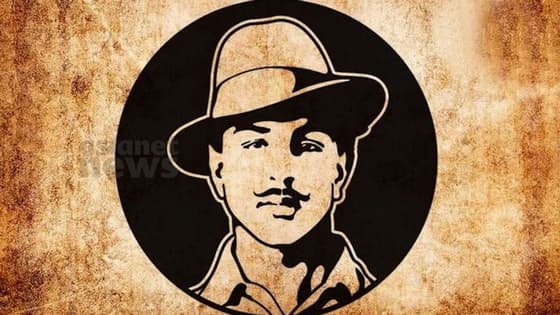
India@75: Bhagat Singh, the revolutionary who moved an entire nation
Born into a nationalist family, Bhagat Singh was attracted to the freedom movement even as a boy. Singh was brought into the political movement while studying at Lahore's National College set up by nationalist leader Lala Lajpat Rai.
Lahore Railway Station, 1928: A young man in a western dress and his wife enter the train for Howrah. The husband has a sleeping baby in his hands. Another youth too is with them carrying their luggage. All of them got down as the train reached Lucknow and proceeded to their hideout. They were Bhagat Singh and his comrades Sukhdev and Durgawati Devi. The child belonged to Devi. They gave the slip to the mighty British Police who were waiting to arrest these dangerous revolutionaries.

Also See: India@75: Batukeshwar Dutt, the revolutionary who deserved more
There is no doubt as to who is India's most famous martyr for freedom. Shaheed Bhagat Singh. He was born on September 27, 1907, in Banga village in Lyallpur district of Punjab, which is now in Pakistan.
Born into a nationalist family, Bhagat Singh was attracted to the freedom movement even as a boy. Singh was brought into the political movement while studying at Lahore's National College, set up by nationalist leader Lala Lajpat Rai.
Singh and his young friends did not subscribe to Gandhi's non-violence and believed in the armed struggle against the British. Singh formed the Hindustan Socialist Republic Association in 1928. Revolutionary nationalism, Marxism, and anarchism were the guiding ideologies. Bhagat Singh wrote prolifically against foreign dominance.
October 1928. Lala Lajpat Rai was grievously injured while leading a march against Simon Commission at Lahore. Rai passed away some days later, sinking the nation in sorrow and anger. Bhagat Singh and his young comrades resolved to avenge their hero's death. On December 17, 1928, Singh and others shot dead police officer John Saunders in Lahore and escaped in cycles. Singh's comrade Chandrasekhar Azad shot and killed another police constable who tried to chase them.
Also read: India@75: Batukeshwar Dutt, the revolutionary who deserved more
Four months later, Bhagat Singh and his comrades strike again. Singh and Batukeswar Dutt hurled bombs inside Delhi legislative assembly. Without trying to escape through the smoke-filled assembly hall, Singh and Dutt surrendered to the police. The Sanders assassination came to be known as the Lahore case. Among the 24 accused, Bhagat Singh, Rajguru and Sukhdev were sentenced to death. Their sensational trial rocked the country.
Despite opposing the youngsters' violent path, Mahatma Gandhi, Jawaharlal Nehru, and Mohammad Ali Jinnah campaigned against their execution. Bhagat Singh and his comrades held a hunger strike against discrimination inside prison for 116 days, making them heroes of the country.
Jatin Das, one of the accused in the case, became a martyr observing the fast, which stunned the country. Bhagat Singh even refused to engage a lawyer. Shouting Inquilab zindabad, Bhagat Singh, Sukhdev and Rajguru walked to the gallows on March 23, 1931. Their bodies were not handed over to their relatives but secretly cremated, and ashes were thrown into the Sutlej river.
Also watch: India@75: Polygars, the greatest challenge to East India Company
Also watch: India@75: Inspiring story of Haipou Jadonang Malangmei, the legendary Naga leader